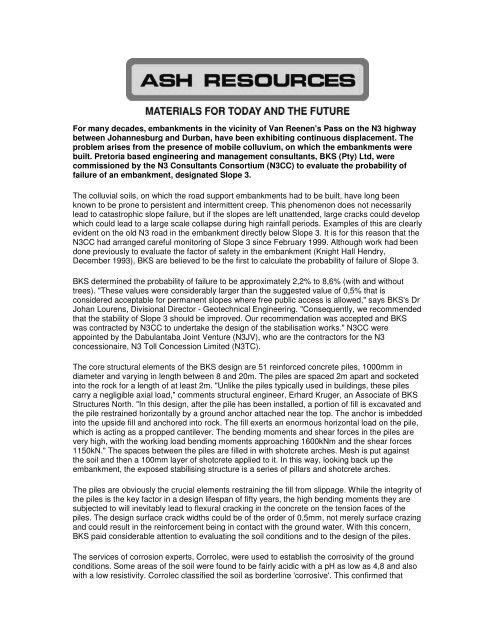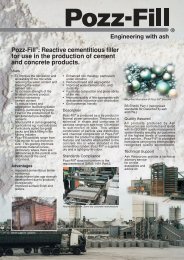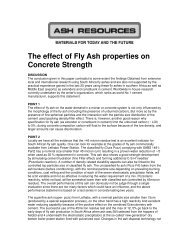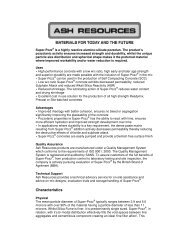For many decades, embankments in the vicinity of ... - Ash Resources
For many decades, embankments in the vicinity of ... - Ash Resources
For many decades, embankments in the vicinity of ... - Ash Resources
- No tags were found...
Create successful ePaper yourself
Turn your PDF publications into a flip-book with our unique Google optimized e-Paper software.
<strong>For</strong> <strong>many</strong> <strong>decades</strong>, <strong>embankments</strong> <strong>in</strong> <strong>the</strong> vic<strong>in</strong>ity <strong>of</strong> Van Reenen's Pass on <strong>the</strong> N3 highway<br />
between Johannesburg and Durban, have been exhibit<strong>in</strong>g cont<strong>in</strong>uous displacement. The<br />
problem arises from <strong>the</strong> presence <strong>of</strong> mobile colluvium, on which <strong>the</strong> <strong>embankments</strong> were<br />
built. Pretoria based eng<strong>in</strong>eer<strong>in</strong>g and management consultants, BKS (Pty) Ltd, were<br />
commissioned by <strong>the</strong> N3 Consultants Consortium (N3CC) to evaluate <strong>the</strong> probability <strong>of</strong><br />
failure <strong>of</strong> an embankment, designated Slope 3.<br />
The colluvial soils, on which <strong>the</strong> road support <strong>embankments</strong> had to be built, have long been<br />
known to be prone to persistent and <strong>in</strong>termittent creep. This phenomenon does not necessarily<br />
lead to catastrophic slope failure, but if <strong>the</strong> slopes are left unattended, large cracks could develop<br />
which could lead to a large scale collapse dur<strong>in</strong>g high ra<strong>in</strong>fall periods. Examples <strong>of</strong> this are clearly<br />
evident on <strong>the</strong> old N3 road <strong>in</strong> <strong>the</strong> embankment directly below Slope 3. It is for this reason that <strong>the</strong><br />
N3CC had arranged careful monitor<strong>in</strong>g <strong>of</strong> Slope 3 s<strong>in</strong>ce February 1999. Although work had been<br />
done previously to evaluate <strong>the</strong> factor <strong>of</strong> safety <strong>in</strong> <strong>the</strong> embankment (Knight Hall Hendry,<br />
December 1993), BKS are believed to be <strong>the</strong> first to calculate <strong>the</strong> probability <strong>of</strong> failure <strong>of</strong> Slope 3.<br />
BKS determ<strong>in</strong>ed <strong>the</strong> probability <strong>of</strong> failure to be approximately 2,2% to 8,6% (with and without<br />
trees). "These values were considerably larger than <strong>the</strong> suggested value <strong>of</strong> 0,5% that is<br />
considered acceptable for permanent slopes where free public access is allowed," says BKS's Dr<br />
Johan Lourens, Divisional Director - Geotechnical Eng<strong>in</strong>eer<strong>in</strong>g. "Consequently, we recommended<br />
that <strong>the</strong> stability <strong>of</strong> Slope 3 should be improved. Our recommendation was accepted and BKS<br />
was contracted by N3CC to undertake <strong>the</strong> design <strong>of</strong> <strong>the</strong> stabilisation works." N3CC were<br />
appo<strong>in</strong>ted by <strong>the</strong> Dabulantaba Jo<strong>in</strong>t Venture (N3JV), who are <strong>the</strong> contractors for <strong>the</strong> N3<br />
concessionaire, N3 Toll Concession Limited (N3TC).<br />
The core structural elements <strong>of</strong> <strong>the</strong> BKS design are 51 re<strong>in</strong>forced concrete piles, 1000mm <strong>in</strong><br />
diameter and vary<strong>in</strong>g <strong>in</strong> length between 8 and 20m. The piles are spaced 2m apart and socketed<br />
<strong>in</strong>to <strong>the</strong> rock for a length <strong>of</strong> at least 2m. "Unlike <strong>the</strong> piles typically used <strong>in</strong> build<strong>in</strong>gs, <strong>the</strong>se piles<br />
carry a negligible axial load," comments structural eng<strong>in</strong>eer, Erhard Kruger, an Associate <strong>of</strong> BKS<br />
Structures North. "In this design, after <strong>the</strong> pile has been <strong>in</strong>stalled, a portion <strong>of</strong> fill is excavated and<br />
<strong>the</strong> pile restra<strong>in</strong>ed horizontally by a ground anchor attached near <strong>the</strong> top. The anchor is imbedded<br />
<strong>in</strong>to <strong>the</strong> upside fill and anchored <strong>in</strong>to rock. The fill exerts an enormous horizontal load on <strong>the</strong> pile,<br />
which is act<strong>in</strong>g as a propped cantilever. The bend<strong>in</strong>g moments and shear forces <strong>in</strong> <strong>the</strong> piles are<br />
very high, with <strong>the</strong> work<strong>in</strong>g load bend<strong>in</strong>g moments approach<strong>in</strong>g 1600kNm and <strong>the</strong> shear forces<br />
1150kN." The spaces between <strong>the</strong> piles are filled <strong>in</strong> with shotcrete arches. Mesh is put aga<strong>in</strong>st<br />
<strong>the</strong> soil and <strong>the</strong>n a 100mm layer <strong>of</strong> shotcrete applied to it. In this way, look<strong>in</strong>g back up <strong>the</strong><br />
embankment, <strong>the</strong> exposed stabilis<strong>in</strong>g structure is a series <strong>of</strong> pillars and shotcrete arches.<br />
The piles are obviously <strong>the</strong> crucial elements restra<strong>in</strong><strong>in</strong>g <strong>the</strong> fill from slippage. While <strong>the</strong> <strong>in</strong>tegrity <strong>of</strong><br />
<strong>the</strong> piles is <strong>the</strong> key factor <strong>in</strong> a design lifespan <strong>of</strong> fifty years, <strong>the</strong> high bend<strong>in</strong>g moments <strong>the</strong>y are<br />
subjected to will <strong>in</strong>evitably lead to flexural crack<strong>in</strong>g <strong>in</strong> <strong>the</strong> concrete on <strong>the</strong> tension faces <strong>of</strong> <strong>the</strong><br />
piles. The design surface crack widths could be <strong>of</strong> <strong>the</strong> order <strong>of</strong> 0,5mm, not merely surface craz<strong>in</strong>g<br />
and could result <strong>in</strong> <strong>the</strong> re<strong>in</strong>forcement be<strong>in</strong>g <strong>in</strong> contact with <strong>the</strong> ground water. With this concern,<br />
BKS paid considerable attention to evaluat<strong>in</strong>g <strong>the</strong> soil conditions and to <strong>the</strong> design <strong>of</strong> <strong>the</strong> piles.<br />
The services <strong>of</strong> corrosion experts, Corrolec, were used to establish <strong>the</strong> corrosivity <strong>of</strong> <strong>the</strong> ground<br />
conditions. Some areas <strong>of</strong> <strong>the</strong> soil were found to be fairly acidic with a pH as low as 4,8 and also<br />
with a low resistivity. Corrolec classified <strong>the</strong> soil as borderl<strong>in</strong>e 'corrosive'. This confirmed that
special precautionary measures were required to ensure <strong>the</strong> durability <strong>of</strong> <strong>the</strong> concrete and <strong>the</strong><br />
re<strong>in</strong>forcement.<br />
The key to produc<strong>in</strong>g strong durable concrete is to use a low water/cement ratio <strong>of</strong> 0,5 and to<br />
blend <strong>the</strong> cement with a pozzolan. "We have been and are <strong>in</strong>volved <strong>in</strong> design<strong>in</strong>g a wide range <strong>of</strong><br />
water reta<strong>in</strong><strong>in</strong>g structures," says Kruger. "We did <strong>the</strong> designs for <strong>the</strong> Grand Central Water Tower,<br />
<strong>the</strong> 9 megalitre reservoir at Kopanong <strong>in</strong> <strong>the</strong> W<strong>in</strong>terveldt, Venterdorp Sewage Works and<br />
numerous reservoirs. In all <strong>of</strong> <strong>the</strong>m we used Dura-Pozz ® , <strong>the</strong> quality fly ash from <strong>Ash</strong> <strong>Resources</strong><br />
as <strong>the</strong> pozzolan. We have always been very pleased with <strong>the</strong> performance <strong>of</strong> Dura-Pozz ® mixes<br />
and <strong>the</strong> real benefits that <strong>the</strong>y impart to <strong>the</strong> concrete. The density and impermeability is improved<br />
while for mass pours, <strong>the</strong> heat <strong>of</strong> hydration is lowered. The <strong>of</strong>f-shutter f<strong>in</strong>ish is excellent and even<br />
if f<strong>in</strong>e cracks develop through a structure with some leakage, <strong>the</strong>re is <strong>the</strong> benefit <strong>of</strong> autogenous<br />
heal<strong>in</strong>g. In <strong>the</strong> presence <strong>of</strong> Dura-Pozz ® , f<strong>in</strong>e cracks tend to seal <strong>the</strong>mselves over time."<br />
<strong>For</strong> <strong>the</strong> pile design BKS wanted to take extra precautions by achiev<strong>in</strong>g an even denser and more<br />
durable concrete. They decided to <strong>in</strong>corporate <strong>the</strong> ultra-f<strong>in</strong>e fly ash, Super-Pozz ® <strong>in</strong> <strong>the</strong> mix as<br />
well as Dura-Pozz ® . The size <strong>of</strong> Dura-Pozz ® is typically 90% pass<strong>in</strong>g a 45 micron sieve, whereas<br />
for Super-Pozz ® , 90% passes an 11 micron sieve. Super-Pozz ® is a product from Micron<br />
Materials, an associate company <strong>of</strong> <strong>Ash</strong> <strong>Resources</strong>. Although it is quite possibly <strong>the</strong> first time <strong>in</strong><br />
South Africa that <strong>the</strong> two products have been used toge<strong>the</strong>r <strong>in</strong> a concrete mix, both are well<br />
established <strong>in</strong> <strong>the</strong> Middle East. In <strong>the</strong> highly corrosive and aggressive environment <strong>of</strong> <strong>the</strong> Arabian<br />
Gulf, Dura-Pozz ® , used <strong>in</strong> conjunction with Super-Pozz ® , have become established as standard<br />
specified cement extenders <strong>in</strong> high durability concrete mixes, particularly for mar<strong>in</strong>e structures.<br />
The R8,6 million contract for construct<strong>in</strong>g <strong>the</strong> pil<strong>in</strong>g stabilisation barrier was awarded to Ground<br />
Eng<strong>in</strong>eer<strong>in</strong>g (GEL) and <strong>the</strong>y started work on site <strong>in</strong> September 2003. They approached Lafarge<br />
South Africa's Product Assistance Department (PAD) to help with <strong>the</strong> design <strong>of</strong> <strong>the</strong> required mix.<br />
The orig<strong>in</strong>al <strong>in</strong>tention had been to use Lafarge's Buildcrete 32,5N, a blended CEM II/B-V 32,5N<br />
cement, which <strong>in</strong>corporated Dura-Pozz ® and to add 5% Super-Pozz ® . However, this comb<strong>in</strong>ation<br />
would have pushed extender content higher than <strong>the</strong> specified maximum <strong>of</strong> 30%. At <strong>the</strong> time,<br />
Lafarge had just launched a successor to Buildcrete 32,5N <strong>in</strong> <strong>the</strong> form <strong>of</strong> Buildcrete 42,5N, a<br />
CEM II/A-V 42,5N formulation conta<strong>in</strong><strong>in</strong>g 17% Dura-Pozz ® . PAD proposed that this should be<br />
used to blend with 6% Super-Pozz ® . The proposal was approved by BKS.<br />
In view <strong>of</strong> <strong>the</strong> low water/cement ratio be<strong>in</strong>g used <strong>in</strong> <strong>the</strong> mix, a Chryso admixture was also added<br />
to improve workability.<br />
Super-Pozz ® is a highly reactive alum<strong>in</strong>o-silicate pozzolan with a unique particle size distribution.<br />
With a mean particle diameter typically rang<strong>in</strong>g between 3,9 and 5,0 micron, Super-Pozz ® 's bimodal<br />
distribution and ultra-f<strong>in</strong>e particle size effectively fills <strong>the</strong> void spaces between <strong>the</strong><br />
cementitious components, creat<strong>in</strong>g an ideal f<strong>in</strong>e filler effect. With durability be<strong>in</strong>g a key factor <strong>in</strong><br />
<strong>the</strong> design <strong>of</strong> <strong>the</strong> piles, <strong>the</strong> dense paste matrix produced with Super-Pozz ® addition was ideal.<br />
Design<strong>in</strong>g an impermeable, high durability concrete was still not sufficient for BKS. Corrolec had<br />
advised that galvanic corrosion was a possibility, result<strong>in</strong>g from <strong>the</strong> exposure <strong>of</strong> re<strong>in</strong>forcement to<br />
ground water at flexural cracks. Although cathodic protection <strong>of</strong> <strong>the</strong> re<strong>in</strong>forcement would have<br />
been <strong>the</strong> cheapest option, it requires regular ma<strong>in</strong>tenance and <strong>the</strong> equipment is vulnerable to<br />
vandalism. Hot dip galvanised re<strong>in</strong>forcement was also ruled out because <strong>of</strong> <strong>the</strong> acidic nature <strong>of</strong><br />
<strong>the</strong> soil. BKS f<strong>in</strong>ally decided to use 3CR12 re<strong>in</strong>forc<strong>in</strong>g <strong>in</strong> <strong>the</strong> piles <strong>in</strong> conjunction with a 75mm<br />
concrete cover. This added ano<strong>the</strong>r dimension to <strong>the</strong> construction cost control. With <strong>the</strong> fairly high<br />
unit price <strong>of</strong> 3CR12 compared with normal steel, it was important to optimise <strong>the</strong> cutt<strong>in</strong>g lengths<br />
to m<strong>in</strong>imise wastage.<br />
"This has been a particularly <strong>in</strong>terest<strong>in</strong>g project for BKS," comments Rudi Kühn, Project Director<br />
<strong>of</strong> BKS, "start<strong>in</strong>g with <strong>the</strong> challenge <strong>of</strong> establish<strong>in</strong>g <strong>the</strong> probability <strong>of</strong> failure <strong>of</strong> an embankment
that has been on <strong>the</strong> move for more than ten years. On <strong>the</strong> structural eng<strong>in</strong>eer<strong>in</strong>g side, we <strong>the</strong>n<br />
had to design piles to withstand abnormal and extremely high loads. This <strong>in</strong>volved non-standard<br />
re<strong>in</strong>forc<strong>in</strong>g and a highly specified concrete which saw <strong>the</strong> first use <strong>of</strong> Super-Pozz ® <strong>in</strong> South Africa<br />
for such an application. The work went well - <strong>the</strong> depth <strong>of</strong> <strong>the</strong> rock, <strong>the</strong> consistency <strong>of</strong> <strong>the</strong> soil and<br />
<strong>the</strong> water conditions gave us no nasty surprises and we f<strong>in</strong>ished on schedule <strong>in</strong> December,<br />
2003."







